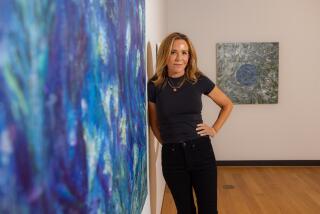British Painter Francis Bacon Dies : Art: At 82, he remained a figure of controversy whose powerful, boldly painted canvases divided critics and viewers alike.
- Share via
LONDON — Francis Bacon, widely regarded as Britain’s greatest contemporary painter, died of a heart attack in a Madrid hospital Tuesday.
Bacon, who had suffered from asthma, became ill while visiting friends in Spain.
The 82-year-old painter was highly controversial in traditional artistic circles, since his powerful canvases, executed with splashing brush strokes, were often concerned with the themes of sex, suffering and death. Many regarded his paintings as obscene.
But his work commanded high prices--a Bacon triptych recently sold in New York for $7 million--and in 1975 he was the first living British artist to rate a one-man show at New York’s Metropolitan Museum.
Bacon reportedly turned down a knighthood and other honors on the grounds, as he once said with a shrug, that “they cordon you off from existence.”
In 1962, his large retrospective exhibition at London’s Tate Gallery received considerable public and critical acclaim. Additional attention focused on his paintings in 1971, when he was given a rare retrospective at Paris’ Grand Palais that opened only hours after his model and lover, George Dyer, had committed suicide.
Bacon later memorialized Dyer’s death in a famous triptych of tormented paintings. It was reminiscent of one of his first works to draw international attention--a triptych called “Three Studies for the Figures at the Base of a Crucifixion.”
His paintings often depicted people such as Dyer in the throes of drug addiction and other agonies, and his “Screaming Pope” series was an unsettling reference to Diego Velazquez’s portrait of Pope Innocent X.
Bacon was an avowed homosexual who lived in a paint can-cluttered apartment and hung around the bars of London’s raffish Soho district.
While reticent about his work, he was personable and charming outside his studio. Bacon often said that his life was divided between “the gutter and the Ritz.”
He normally consumed at least a bottle of champagne and a dozen oysters for lunch, and when not working he would pub-crawl through the day in Soho, often ending in fashionable South Kensington, where he lived and worked in a simple two-bedroom townhouse.
He wandered the streets in a dark leather jacket, looking at least 10 years younger than his age and seldom recognized.
Bacon seemed to care little about money, deploring the astronomical prices of paintings--including his own--with the comment, “Prices are so ridiculous that people go to galleries because they are obsessed by the money.”
He was born in Ireland in 1909, reportedly descended from the 16th-Century English philosopher and essayist whose name he bore.
His English father was a retired army officer who banished him from home when Bacon was caught having sex with a stable hand.
The teen-ager struck out for London and then Berlin, where he quickly began indulging in sexual escapades, gambling and nights in transvestite clubs.
He returned to London in 1923 and designed modernistic furniture. It was not until 1929 that he turned to painting.
In the 1930s, his supporters claimed that his work was revitalizing the British art scene. At the outbreak of the war, he tried to enlist but, rejected because of his longstanding asthma, joined the ambulance rescue squad instead.
It was about this time that he decided his early work displeased him, and he destroyed much of it with a razor.
In his work, Bacon broke all the staid rules of traditional English art and followed a more European tradition. With no formal art training, he sometimes painted with his fingers, scrubbing brushes and rags, combining different images from different mediums to produce startling pictures.
To those who abhorred his depiction of flesh--animal, human, and sometimes indeterminate--he once said: “You’ve only got to go into a butcher’s shop. . . . It’s nothing to do with mortality, but it’s to do with the great color of the meat.”
Times art critic William Wilson, writing of a Bacon exhibit at the Los Angeles County Museum of Art two years ago, likened the artist to an Irish countryman, the playwright Samuel Beckett.
Both men were philosophical exiles, Wilson said, “and (both) shocked the world with radical, disturbing art . . . which has changed only in nuance over the decades. . . .
“It seems fair to ask how anyone as immensely successful--and presumably wealthy--as Bacon can go on making art about despair. The quick answer to that is that the rich and famous are still not necessarily content, and Bacon has been strange and haunted all his life. . . . “
Bacon was once asked about the hostility that his paintings created among some viewers and answered, “If I thought about what the critics said, I shouldn’t have gone on painting.”
He did not explain his obsession with sex and death in his paintings, but said, “If you really love life you’re constantly walking in the shadow of death.
“I don’t emphasize death,” he continued. “I accept it as part of one’s existence. One is always aware of mortality in life, even in a rose that blooms and then dies.”
PRIVATE TORMENT: Times critic William Wilson reviews artist’s tortured life. F1
More to Read
The biggest entertainment stories
Get our big stories about Hollywood, film, television, music, arts, culture and more right in your inbox as soon as they publish.
You may occasionally receive promotional content from the Los Angeles Times.










